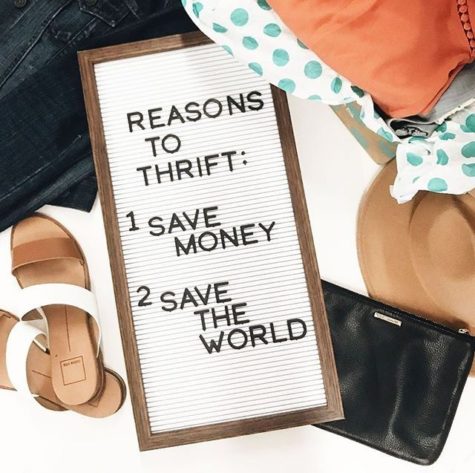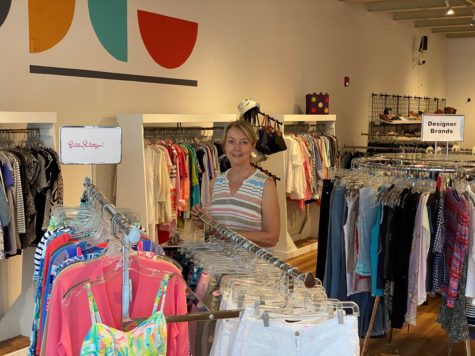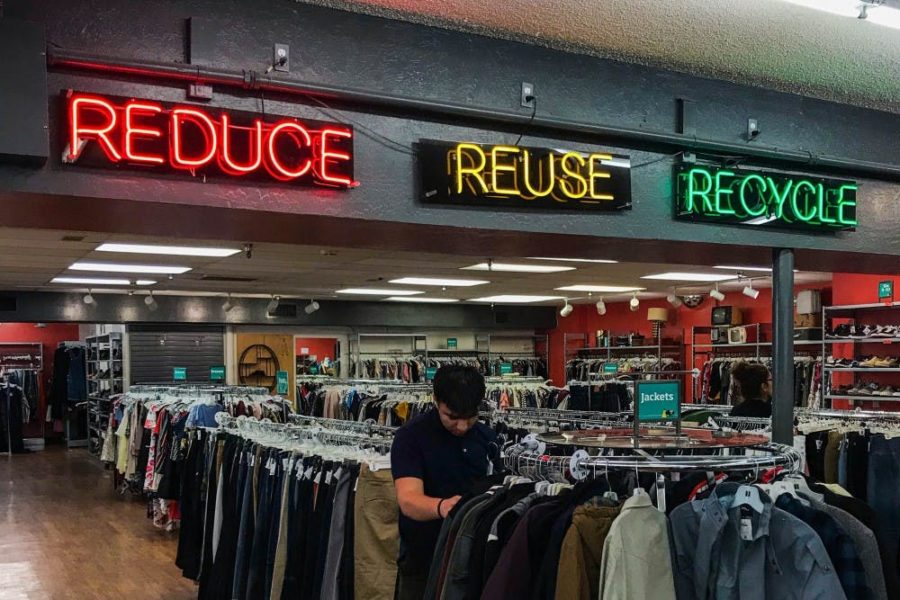Saving the Environment, One Sweater at a Time
October 4, 2021
Throwing out clothes that fall out of favor in your wardrobe may seem like business as usual, but where do all those clothes really go? The average American is responsible for throwing away approximately 70 pounds of clothing per year, filling up landfills at a rapid rate. Luckily, a creative and viable solution exists; thrifting.
As thrifting has risen in popularity, it’s important for people to understand how beneficial the practice is. Thrifting has long been a useful tool to save money when shopping, but only recently has it become known as a climate-saving practice and an easy way to help save the environment. On average, 85% of clothes in the U.S end up in landfills. By thrifting, you ensure that your old clothes have a new purpose and many people would even be surprised to know that making your wardrobe more sustainable reduces your water footprint. As stated in Water Footprint Calculator, “Water is involved in almost every stage of clothing production.” Imagine all the water used in making just one shirt. Now multiply that by the average 80 billion pieces of clothing made per year. Disappointingly, the terrifying statistics don’t end there. Clothing production causes a tremendous amount of chemical pollution that can go unnoticed. Inorganic dyes and oil by-products oftentimes enter our land and water through runoff.

Thrifting creates a second option that is cruelty-free to our planet. Not only is second-hand shopping valuable to our beautiful planet, but it also can be very beneficial to your wardrobe. Oftentimes thrifting can provide people with unique clothing that isn’t as commonly found in mainstream stores. Whether you’re looking for unique pieces or staples that bring your closet together, thrift stores have the things you need. And, even better, they are kind to your wallet. What could be better than interesting clothes for cheap prices? A second-hand dress could be under five dollars depending on where you visit. Some stores even have different varieties or cater to certain things. A consignment shop I visited in Beverly was very aware of what is popular in modern fashion. Most thrift stores categorize either by color or by seasonal clothing. Local thrift shops that you can visit, within a 25-mile radius, are Savers in Plaistow and Portsmouth, Goodwill in Seabrook, Gentry’s in Newburyport, Share the Love Consignment in Andover, and more! Whether you’re looking for a new blazer or a comfy sweater, thrifting guarantees a new piece that you’ll love with a lot less guilt.
Gentry’s, Newburyport
50 Water Street, Newburyport, MA



Vivian • Oct 7, 2021 at 10:10 am
Neve, this article is incredible! I truly had no idea how much I would enjoy this article. My knowledge has sufficiently expanded on thrifting. I am not a typical thrifter but after reading this article, I am now so much more interested in second-hand clothing. I had no idea how much water was spent on the making of one shirt. Not only thrifting can be fun but it can be helpful to the environment. Your work in Dr.Ruland’s class has shown off big. Good job
Gabriella Brancato • Oct 7, 2021 at 10:00 am
This article really opened my eyes to how important thrifting is environmentally. The statistics included in the article really made me think about thrifting more often. Your paragraphs were not only informative, they also written very nicely. Each sentence flowed in to each other, and your transition words were on point. Your work in Dr. Ruland’s class has really payed off because this article was extravagant. Very nice article Neve.
Dr. Clara Cavallini • Oct 7, 2021 at 9:51 am
I have never thought about the benefits of thrifting and how it can help the environment. It is an idea that never passed my mind. I see now how throwing clothes away is bad for the environment. This article has brought new insight into my life about thrift stores and how much I can help the environment. This article was wonderful Neve. Keep up the good work and keep making Robert Ruland and me proud!
Mia Bartholomew • Oct 7, 2021 at 9:49 am
I really loved the facts that you put in this. You did an amazing job on this, I am very proud of you! Great job and keep doing great!
Sophia Nickerson • Oct 7, 2021 at 9:46 am
Neve, this is absolutely spectacular and exciting, I can’t tell how much thought you put into this! While reading this I learned some new things I never knew before, absolutely life-changing! I can’t put into words how proud I am of your article and most importantly how proud you had made Dr. Robert Ruland. In the writing lab, Ruland and I always see Neve’s excellence and how she is a class leader, amazed that it made it in the school paper! Job well done Neve, keep making the writing lab class of Ruland proud!
Mr. Casey • Oct 5, 2021 at 1:36 pm
Excellent article, Neve!
Brooke Zaneski • Oct 4, 2021 at 7:27 pm
Before reading this article, I was unaware of the benefits to thrifting. I am one of the many people who have improperly disposed of old clothing. Despite trying to recycle cardboard and plastic, I was still negatively impacting the environment. I was surprised to read that our water footprint is affected by manufacturing facilities. Now that my knowledge has expanded, I can help revise my habits. Moreover, I can encourage others to go thrifting. Overall, this article is interesting, helpful, and informative. I am grateful to have learned more about second-hand shopping.